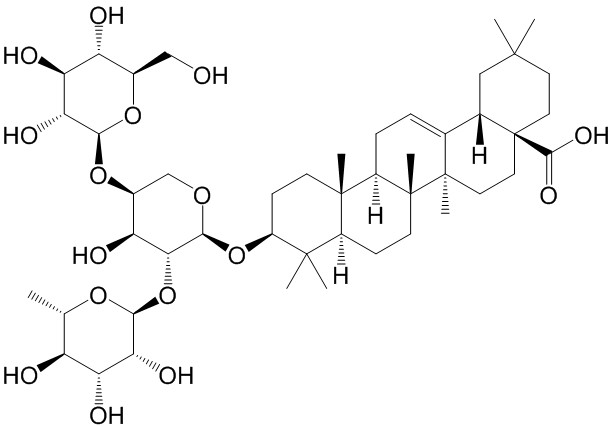Home
Products
Hederacolchiside A1



| Product Name | Hederacolchiside A1 |
| Price: | $131 / 20mg |
| Catalog No.: | CN07487 |
| CAS No.: | 106577-39-3 |
| Molecular Formula: | C47H76O16 |
| Molecular Weight: | 897.10 g/mol |
| Purity: | >=98% |
| Type of Compound: | Triterpenoids |
| Physical Desc.: | Powder |
| Source: | The rhizomes of Anemone raddeana Regel |
| Solvent: | DMSO, Pyridine, Methanol, Ethanol, etc. |
| SMILES: | OCC1OC(OC2COC(C(C2O)OC2OC(C)C(C(C2O)O)O)OC2CCC3(C(C2(C)C)CCC2(C3CC=C3C2(C)CCC2(C3CC(C)(C)CC2)C(=O)O)C)C)C(C(C1O)O)O |
| Contact us | |
|---|---|
| First Name: | |
| Last Name: | |
| E-mail: | |
| Question: | |
| Description | Hederacolchiside A1, isolated from Pulsatilla chinensis, suppresses proliferation of tumor cells by inducing apoptosis through modulating PI3K/Akt/mTOR signaling pathway[1]. Hederacolchiside A1 has antischistosomal activity, affecting parasite viability both in vivo and in vitro[2]. |
| Target | PI3K Akt mTOR |
| In Vitro | Hederacolchiside A1 reduces the mitochondrial membrane potential and Bcl-2 protein levels, whereas cleaved caspase-3 was higher[1]. Hederacolchiside A1 effectively inhibits the phosphorylations of phosphatidylinositol 3 kinase (PI3K), protein kinase B (Akt), and mammalian target of rapamycin (mTOR) [1]. |
| In Vivo | hederacolchiside A1 (3.0, 4.5, and 6.0 mg/kg, ip) can significantly inhibit the weight of tumor in an H22 xenograft model[1]. Hederacolchiside A1 (3.25, 7.5, and 15.0 mg/kg, ig) can significantly inhibit the weight of tumor in nude mice xenograft tumor models using human breast carcinoma MCF-7 cells[1]. |
| Density | 1.36±0.1 g/cm3 (20 ºC 760 Torr) |
| Boiling Point | 967.2±65.0 °C at 760 mmHg |
| Flash Point | 276.2±27.8 °C |
| Exact Mass | 896.513306 |
| LogP | 7.36 |
| Vapour Pressure | 0.0±0.6 mmHg at 25°C |
| Storage condition | 2-8℃ |